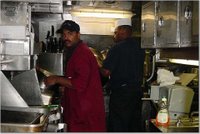
My daughter’s comments on the food at Girl Scout camp got me thinking about food on the boat. It’s often claimed that submariners get the best food in the Navy. Both submariners and skimmers say this; in fact, the first time I heard it was from my brother, a retired skimmer, when I told him what my career plans were.
As far as the quality of the food went, it was pretty much the same on boats as elsewhere – it depended on the cook. We had some really good cooks on my boats (such as Mike on my first boat and Dee on my last) and some really bad ones (whose names shall remain unmentioned) as well. I spent three years on a skimmer, and the main difference I noticed was the concept of portion control. On the boats, portions were liberal and adjustable (“A bit more of that, please.”), and seconds were available. On my last boat, in fact, the food was set out on the serving line, and you went through and helped yourself, taking as much as you wanted. On the skimmer, on the other hand, you were given one “serving” of each food item (and only one entrée choice), and seconds were usually out of the question. (Though when we were authorized to eat on Emory S Land, during my last deployment, a lot of items were self-serve.)
Another noticeable difference was the fact that on board the tender, the galley and mess decks were secured between meals – you couldn’t even go get a cup of coffee or a glass of milk. On the boat, of course, the drinks were available 24/7 (until the milk ran out, anyway), the bread and PB were almost always available, and there might even be something in the day box. The cake the cooks made for dessert didn’t get finished during the meal? What’s left of it stayed out, available for anyone who came along later and wanted a piece.
The skimmer was where I learned to like barbecue sauce – I always took the barbecued beef cubes because the accompanying entrée, whatever it was, was something I liked even less. On my first boat, my favourite dish was a fried-chicken variant called Maryland fried chicken; I tried to get a copy of the recipe later, but it wasn’t included on the deck of recipe cards they used on my last boat. On the other hand, the cooks on my last boat prepared a wonderful dish called beef Napoli that I’ve never been able to find a recipe for; it involved chunks of beef, pepperoni, tomatoes, onions and green peppers. And I think it was my second boat that introduced me to Monte Cristo sandwiches.
Under way, meals were served every six hours, and the type of meal served depended on the time of day (according to ship’s clocks) – breakfast 0500-0600, lunch 1100-1200, supper 1700-1800, and midrats 2300-2400. Watch reliefs occurred in the middle of each meal, so the oncoming watch could eat before relieving the watch, and the offgoing could then go eat after being relieved. Since most people, as I noted in a previous post, were on an 18-hour schedule, this led to some interesting meal plans.
For instance, one day you might wake up, get out of bed, and go eat breakfast (sausage and eggs, say, and French toast) before taking the watch. You would then get off watch six hours later, and go eat lunch (hamburgers and fries) before hitting the rack and sleeping through supper. Wake up again, with help from the messenger of the watch, and go eat midrats (leftover pork chops from supper, maybe, or tinned ravioli). Get off watch, eat breakfast (pancakes and bacon), and go back to bed. &c, &c, &c. Do this long enough, and you get used to the idea that anything that’s good for one meal is also good for any other meal.
Food got interesting nicknames on the boat. The tinned ravioli mentioned above, for instance was known as “pillows of death.” Hamburgers were universally called “sliders,” presumably because of their behaviour on the grill; my boot-camp company commander referred to hot dogs as “rollers,” though on the boat those were usually known as “training aids.” (Think about it....) Salisbury steaks were called “trail markers.” The Navy version of chicken cordon bleu was “fried hamsters” (as was the beef version). And breaded chicken patties were called “chicken pucks” on my first boat, and “chicken wheels” elsewhere.
All this talk about food is making me hungry – think I need to go check the chill box now....











1 comment:
Why not mention them? RO**cough**JAS
Uncle Petey
Post a Comment